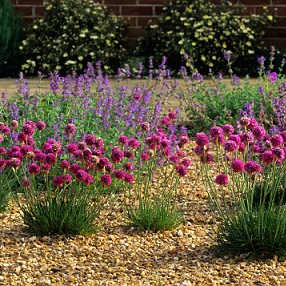Gravel Gardening
Gravel gardening is increasingly popular. That’s partly because plants that will live in gravel tend to be tough, and tolerant of drought, cold and many of the more extreme conditions that we’ve seen over the last few years. Gravel gardens are also fairly low maintenance, apart from the occasional weeding session, and also provide plenty of nectar for visiting pollinators.
 So what do you need to make a gravel garden?
So what do you need to make a gravel garden?
Planning & preparing the site
Gravel garden plants tend to thrive in sandy or gravelly soils, so your plan will work best if you have that kind of soil. Of course you can still try it on clay soils, but you will need to incorporate plenty of organic matter to improve the drainage. A sunny, well-drained site is best.
Consider whether you want your plants to self-seed or not. If not, lay landscape fabric down over the soil before planting, and cut crosses just large enough to insert the rootballs of your plants. This will suppress weed growth and make life a bit easier. Check out compost suppliers and topsoil suppliers, as many also sell gravel in different sizes and colours. Try to match the colour with other stone or paving in your garden, as it will look better. And just for the record, larger sizes of gravel and stones are better for deterring cats from using the garden as a latrine. A bulk bag will cover about 20 square metres, and a 25kg bag about 0.6 square metres.
Planting
There are plenty of suitable plants, from shrubs through perennials to bulbs. Mix and match your colours or choose just one or two colours for a striking effect. Try grasses, Mediterranean plants, anything with grey or furry leaves, as these are generally drought-tolerant, or find a list of suitable plants on the Royal Horticultural Society’s website.
Maintenance
You will need to weed out unwanted seedlings and annual and perennial weeds, especially in the first few years. After that, the plants should be big enough to deter at least some of the weeds. You may also need to top up the gravel level from time to time. As with all gardens, you will need to deadhead in the autumn or early spring.
A last word
To see beautiful gravel gardens in this country, you really need to visit the east of England, where the soil is sandy and the weather relatively dry. Both RHS Hyde Hall and Beth Chatto’s garden have gravel gardens, and you can take a look and see if they take your fancy. They will also give you ideas about the sort of plants you might want to use in your garden, and whether you want to encourage self-seeding. And remember: gravel gardens are low maintenance, but not no maintenance!
